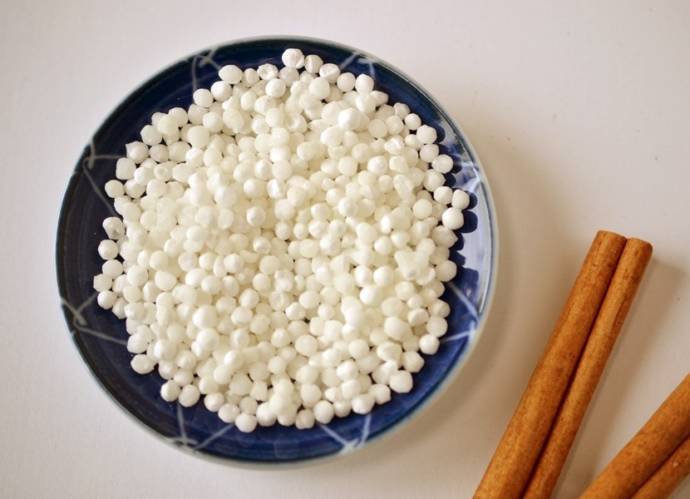Sago or sabudana is a food which is full of energy and carbohydrates. It is extracted from the center of sago palm stems in the form of starch. It is also known as tapioca pearls. If is one of the wholesome diet of starch and carbohydrates and is used in a lot of Indian dishes. Sago is used in puddings, gruel or soups, and upma dishes. In gruel form, it is used in various carbonated drinks to provide energy without any addition of artificial chemicals and sweeteners.
It is one food which possess a high cooling effect in the system and it is quite easy to digest. It is also used in making cakes and breads. Sago is helpful as a substitute in binding the dishes or making them thick. It is low in calories and is preferred as a light meal option. The benefits of eating sago are associated with its starch form as
Aid in digestion
Pearl sago is used as one easily digestible non-irritating baby food, as well as a food in inflammatory cases. In such cases, sabudana is boiled with milk or water and then added with sugar or spices to enhance the flavour.
Nutritional value
Sago grains are about 2 mm in diameter. They are a source of pure carbohydrates with very little protein, vitamin C, calcium and minerals. A hundred gram of dried sago yields about 355 calories, with an inclusion of 94 gms of carbohydrates, fats and proteins.
Sago and the body
The main content of sago is carbohydrates and has an ancient history in aiding to certain herbal medicines. Sago along with rice is used to cool the body. It is helpful in treating ailment resulting from too much heat, such as the production of excess bile. As we know it is a renowned food in Indian culture and moreover, it is a staple diet in some continents. The herbal remedy of sago is not hidden outside the Indian subcontinent such as Sri Lanka, New Guinea and other Asian pacific countries.
Sago dishes
Various dishes are made from sago as it is easily mixed with wide variety of tastes and spices. However, sago is low in proteins, vitamins and minerals, its combination with other supplements can result into high nutrition and taste. In various parts of India, it is used as fasting food in the form of khichdi or pilaf, soaked sabudana fried with potatoes and other vegetables. Sago possess a high usage in baking breads and pancakes.
A high energy booster
Sago food is full of energy, and often served as a food to break the fast. It has high beneficiaries for sick people as a supplement providing enough energy to combat the weakness and ailments.
Keep them in dry and airtight container. It should be kept away from moisture for long storage. The white pearls of sago becomes white when soaked in water and turns translucent when cooked. Fermentation may improve the nutritional value of sabudana. In Papua New Guinea, sabudana paste is partially fermented by mixing it in palm leaves,which are then stored in cool place. Therefore, a lot of recipe with high in energy, you should not be missing it. As experiments can really turn it out in high taste value.
Quick weight gains
In weeks only you can gain weight with the help of sago. People who are suffering from eating disorders or lack of appetite can increase their weight with the help of the rich calorie containing in the tapioca root. Sago has also been suggested to the patients of carcinoma and tuberculosis as it will help them regain the weight that was lost due to these diseases. Having nutritious and healthy components, sago is served as breakfast for the children in India and Pakistan.
Improve joints and bone health
Minerals like calcium, iron and some others are contained by sago which helps in the improvement of joints and bones. The production of Glucosamine is increased with the help of sago which mainly affects the bone density, flexibility and movement of joints. The increase in the production of Glucosamine also increases the amount of synovial fluid which is found in between the joints and tendon sheaths and is also the one responsible for the joints smooth movement.
A very nice antidote for hypertension
Five milligrams of potassium is contained by 100 grams of Sago. Potassium is known for improving the circulation of blood and also the whole cardiovascular system. Sago is considered to be one of the top most cures of hypertension. Tapioca root is being used as a cure for stress and hypertension from the ancient times and hold an important position in the ayurvedic treatment of problems related with cardiovascular system.
Perfect pre/post workout food
High amount carbohydrates is contained by Sago which is considered to be a good substitute for energy giving supplements or post workout supplements. Sago helps us regain the energy that we lost during the workout. If you are look for a good food source of Sago which is easily digestible then go Sago kheer or pudding. Having Sabudana dessert in your breakfast will help to remain energetic the whole day. Sago is known for increasing the production of glucosamine which improves the joints movements and muscle recovery.
Fighting birth defects
Folic acid and vitamin B is contained by Tapioca which helps in the proper growth of the fetus. Regular consumption of it will lead to the prevention of birth defects and neural tube defects.
Muscle growth
For people who are vegan, Tapioca can become a very good protein source. Large amount of protein is contained by it which helps in the growth of muscles and strengthening. Also it contains proteins which increase the process of healing and many other functions of cells.
Blood pressure control
Blood pressure can be kept under control by consuming tapioca. The content of potassium in tapioca encourages healthy blood flow which decreases the strain on cardiovascular system.
FAQs
Consuming sago/sabudana may help improve digestion, provide energy, and regulate blood sugar levels.
Yes, sago/sabudana is a good source of carbohydrates, providing around 75-80% of its calories from carbs.
Yes, consuming sago/sabudana may lead to digestive problems such as bloating, gas, and constipation.
Sago/sabudana is a good source of carbohydrates, along with some proteins, vitamins such as thiamin and riboflavin, and minerals such as calcium, magnesium, potassium, and phosphorus.
Yes, sago/sabudana is a good source of dietary fiber, containing around 1.5 grams of fiber per serving.
Yes, it is important to soak the sago/sabudana prior to consuming it, as this helps to reduce the amount of indigestible starches present in the food.
Yes, sago/sabudana is a good source of protein, providing about 5.2g of protein per 100g of serving.
Yes, sago/sabudana can help manage and control diabetes, as it is low in calories and contains a low glycaemic index, which helps to regulate blood sugar levels.
Yes, sago/sabudana is a rich source of carbohydrates and can provide energy to those with heart disease. It is also low in sodium and fat, making it a good choice for people with heart conditions.
Yes, it is important to soak and cook sago/sabudana properly before consuming as it may contain toxins otherwise.





